Categories: Electrical Reviews
Number of views: 12,423
Comments on the article: 2
Modern types of electric underfloor heating
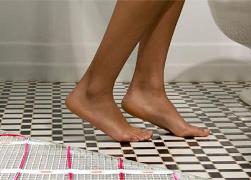 As the main or additional source of heat in modern homes and apartments often use an electric heated floor. Often - as an extra, and there is an opportunity to choose. It can be a continuous floor covering, or just a warm piece of a small area in the hallway.
As the main or additional source of heat in modern homes and apartments often use an electric heated floor. Often - as an extra, and there is an opportunity to choose. It can be a continuous floor covering, or just a warm piece of a small area in the hallway.
For small areas, for example, an ultra-thin heating cable is very convenient, and for large areas a single-core or two-core heating cable (it can go in the form of a mat or on a coil) is better.
The heating cable is mounted under a cement screed, the thickness of which depends on the type of cable. It is best to carry out installation even at the construction stage, or in extreme cases - during the overhaul process.
If repair is not expected, then you can install a warm floor from an ultra-thin cable (in the form of mats or heating sections), which is laid without insulation in a layer of tile adhesive up to 10 mm thick, under a carpet, laminate or linoleum, in this case, you will also get a good source additional heat.
Let us, however, consider the types of modern electric underfloor heating.
Today there are two types:
-
floor heating based on heating cables;
-
film heat-insulated floor.
Cable heating
It is carried out by laying a separate electric cable, which can work on the principle of resistive or self-regulating heat.
Resistive cables
They work due to the action of the well-known Joule-Lenz law when passing electric current through a conductor.
Issued:
-
with one residential;
-
or two.
The number of cores affects the layout and connection to the electrical network.
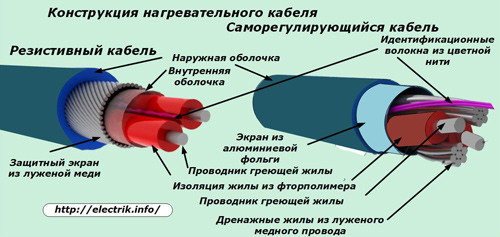
Resistive cables evenly transmit heat along the entire length, require a completely homogeneous structure of the contact surface with the building floor structures, the absence of voids. When cracks form in it, overheating zones are created, heat transfer is disrupted, and the service life is reduced.
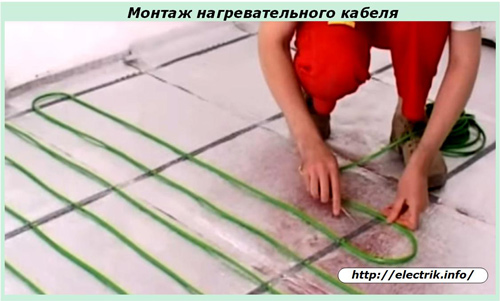
Self-regulating cables
Their structure includes a matrix having a large number of semiconductor elements that respond to temperature by changing the electrical resistance of the corresponding conduction section.
The self-regulating cable itself automatically maintains the required temperature range. At the same time, he is not afraid of environmental temperature differences that are harmful to resistive models because he adapts to them by internal switching of semiconductor elements.
Due to this property, its operating conditions are more extensive.
Heating mats
In principle, they repeat the technology of cable heating, but differ from it in that the cable is evenly distributed at the factory on a fiberglass mesh located in the form of an extended mat twisted by a roll.
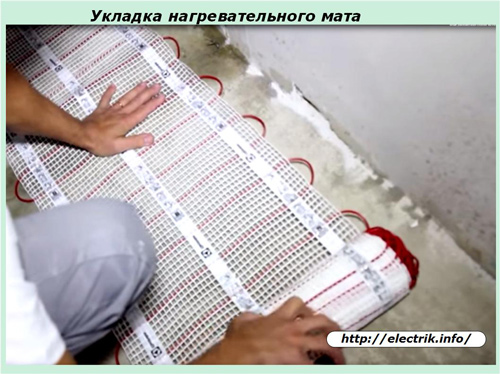
For mounting a thermomat, it is quite enough to roll this roll on the surface of the floor without engaging in laying out the cable, which, in this method, usually has a smaller diameter. This allows you to arrange adjacent sections closer to each other to ensure more uniform heating, eliminating the intervals of the temperature difference on the heated surface.
The technology for laying an electric underfloor heating mats is simpler than for a separate cable. It is more thoughtful, and all fasteners are supplied.
Infrared film emitters
Radiation infrared flux engaged in carbon strips deposited by nano-technology between the layers of the film with a high degree of accuracy.
The current through them is passed through copper buses due to the supply of voltage by connecting wires.
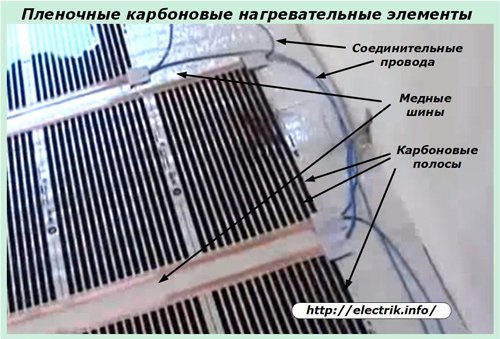
Electro-fluid heating modules
The design is based on a plastic pipe filled with water, which is heated by passing current through the built-in heating filaments.
This design has good heat transfer, high efficiency.
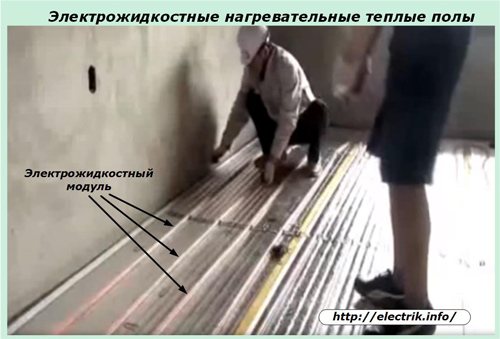
The structures of all four heating elements are described in more detail. separate article. Choose from them the most suitable for your case according to the required heating area, installation method, cost. And in this article in detail about the installation of a warm floor - Technology for laying underfloor heating under tiles
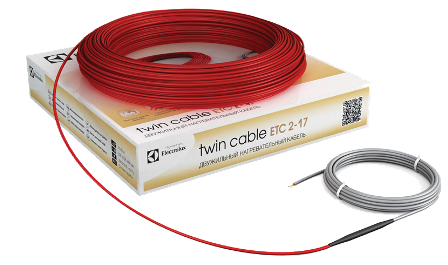
As an example thin two-core shielded heating cable high power (17 W / m) consider a cable ETC 2-17-200 Series Electrolux Twin Cable.
It is easy to understand that both cores of the cable are heating, while the power of one such section is 200 W, which ensures fast floor heating.
Three-layer insulation (insulation of the core, belt insulation, outer sheath) reliably protects the aramid core from damage and overheating during the entire service life. Being laid in tile adhesive, in concrete, or under a stone, such a cable will last a long and reliable time, creating an optimal microclimate in the room.
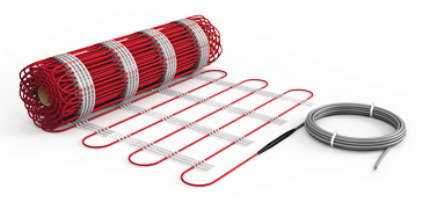
The cable is equipped with a sealed thin sleeve that connects the heating element to the power cord. In this case, the cable itself consists of many thin twisted cores that can be bent without risk, thanks to the aramid (synthetic insulating fiber, 5 times stronger than steel) used in insulation, which takes deforming loads on itself and protects the heating core directly.
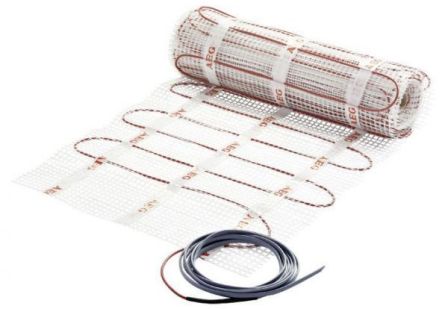
The most common form of warm field are heating mats. They are an adhesive mesh with a heating cable installed on it.
Thanks to the adhesive base, the mat is easily attached to the floor, then you can lay the tiles. The indisputable advantages of mats, such as: easy installation, quick heating, the ability not to fill cement screed, make this type of electric floor heating the most popular.
The twin-core cable is fixed to the grid with a certain step, the grid width is 50 cm. The grid can be easily cut to bend around furniture, etc. When calculating the system, the room area, ceiling height, glazing parameters, wall thickness, their material, etc. are taken into account. For the use of underfloor heating based on electric mats as the main source of heat, the power must reach 180 W /m²If it is only additional heating, then a maximum of 140 W / m² is sufficient.
An example of a heating mat is heating mat AEG HMA TE 50 150. The basis is a shielded two-core heating cable placed on a self-adhesive mesh as a basis. The mat has a thickness of 3 mm and a width of 0.5 m. Designed for mounting under a tile, in a layer of tile adhesive without concrete screed.
The named model has an optimal power of 140 W /m²that allows you to successfully use it as an additional (to the main heating) heat source. The thickness of porcelain stoneware or tiles is not critical here, in addition, the mat is also suitable for wet rooms, because it has a protection class of IPX7.
A relatively new solution is film floor heating. Compared to cable systems, film underfloor heating uses infrared radiation, similar to solar heat. Infrared film floor heating Caleo - One of the most successful and popular representatives of this technology.
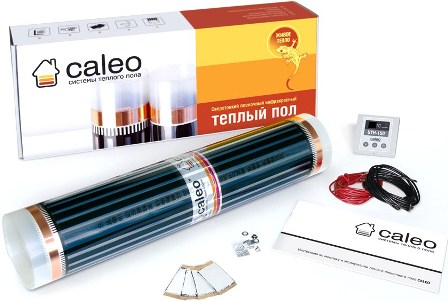
A polymer film consisting of a protective layer, polyester, and a filler of silver and carbon pastes, forming a carbon heating element, has a thickness of only 0.4 mm. GRIDIRON-S proprietary technology prevents the risk of sparking, making the structure safe and reliable.
The mechanism of heat generation here is different from cable floors.The filler in the film is exposed to electric current, which is supplied through copper conductors, resulting in the initiation of infrared radiation, or in other words, thermal radiation, from the surface of the film. Carbon emitters are reliably laminated.
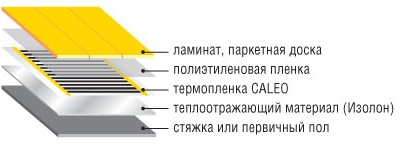
Since the thermal film is quite thin, it can be laid directly under the floor covering, be it linoleum, laminate or carpet, and you do not need a concrete screed or even tile adhesive, that is, the installation is completely dry. Strips with a width of 50-60 cm can be cut along the cut lines, and mounted in sections.
To carry out installation, you do not need professional skills, it is enough to spend a couple of hours of time, and the floor of the middle room will be fully equipped with an economical system (20% more effective than cable).
For small rooms, a film underfloor heating can become a complete replacement for a traditional heating system, besides infrared radiation is useful. In addition, it is worth noting that the thermal strips are connected to the electric network in parallel, so even if one of the strips fails, the rest will continue to work, and you will definitely not be left without heat.
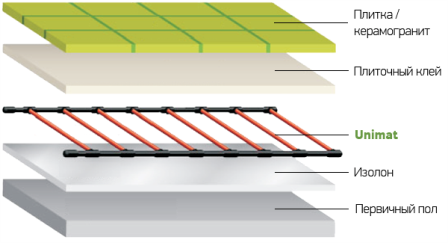
There is another, quite unusual type of infrared warm floor - Unimat infrared heating mat. This technology has no analogues, it is completely innovative. It is based on heating rods consisting of carbon, silver and graphite, connected in a mat.
Mounted such a mat for tiles or porcelain tiles, like cable mats. Mat randomly lengthen or shorten, depending on the room and the structure of the heating zones. The self-regulation function turns off the power of the mat when the set floor temperature is reached, which makes the Unimat mat completely safe, and it does not overheat even if it is locked with furniture.
When disconnected by self-regulation, the rods remain hot, and this gives savings of up to 60% compared to cable floors. Such a mat can become both the main and additional source of heat in the living room.
In the process of laying Unimat under a tile, a heat-reflecting substrate is added, while the total thickness of the tile adhesive together with the floor covering should not be less than 2 cm, so that the system works correctly and the floor warms up evenly.
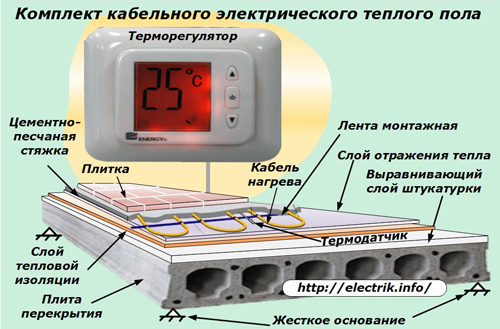
See also at e.imadeself.com
:
